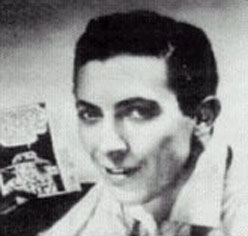Bob Kane’s First and Second Batman Contracts
 In 1938 Bob Kane (shown here, courtesy of NNDB.com) started supplying material for Detective Comics. That material was written by Bill Finger, but Kane kept his scripter's contributions quiet for as long as he could. As a hungry young artist, Kane signed some sort of work-for-hire agreement which granted the magazine publisher full ownership of his material and characters in exchange for some compensation.
In 1938 Bob Kane (shown here, courtesy of NNDB.com) started supplying material for Detective Comics. That material was written by Bill Finger, but Kane kept his scripter's contributions quiet for as long as he could. As a hungry young artist, Kane signed some sort of work-for-hire agreement which granted the magazine publisher full ownership of his material and characters in exchange for some compensation.
Seeing the money that Jerry Siegel and Joe Shuster were earning for their Superman character, Kane decided to create his own costumed crimefighter. In 1939 he and Finger came up with Batman. No one knew that the character would still be incredibly lucrative sixty years later. Kane sold the Batman character to the company that would become DC Comics under the same contract as his previous stories.
Soon Batman was more than just the cover feature of Detective magazine. There was a quarterly, then bimonthly, Batman magazine. There was a Batman adventure each season in World's Finest Comics. There was a movie serial. There were appearances on the Superman radio show. And starting in 1942 there was a daily newspaper comic strip.
That added up to more comics material than Kane and his small studio could put out, so DC commissioned other writers and artists to create Batman stories under his name. Meanwhile, Kane hired his own ghost writers and artists. He apparently gave the most attention to the newspaper strip, just as in this period Joe Shuster chose to draw the Superman strip instead of the comic books.Robert C. Harvey's The Art of the Comic Book offers an economic reason why syndicated strips were more appealing: "The book cartoonist could hope to increase his income only by increasing the number of pages he did...while the strip cartoonist’s income goes up quite independently of the quantity of his output” because it depends on the number of newspapers running the strip.
In 1946, Kane's situation changed in two important ways. First, the Batman and Robin newspaper strip was canceled. That probably hurt his income substantially, even though he had to share the strip's revenue with DC and his ghost writers and artists.
Second, according to Gerard Jones's Men of Tomorrow: Geeks, Gangsters, and the Birth of the Comic Book, late in 1946 Siegel and Shuster contacted Kane to suggest they all renegotiate their contracts with DC at the same time. The Superman creators felt they weren't receiving the rewards the company had promised from ancillary products (radio show, movie cartoons, etc.).
Instead of forming a united front, Kane apparently went to the head of DC Comics and told him about Siegel and Shuster's plans. And then Kane started to renegotiate on his own, using a novel approach. He said that he'd been a minor back when he'd signed his original DC contract--which was therefore unenforceable.It seems clear that Kane was lying about his age. As Comics Should Be Good! pointed out in September, when Kane registered with Social Security, he stated that he'd been born in 1915. His photo appeared in Batman #1 early in 1940 alongside text describing him as age 24. In 1998 his New York Times obituary said both that he died at age 83 (i.e., born in 1915) and that he'd created Batman in 1939 at the age of 18 (i.e., born in 1921).
Other comics creators had met Kane as a fellow high-school student, so they knew he was lying. But DC couldn't prove it. There was no government record of Kane's birth, and his family was backing up his story. Furthermore, with the Superman lawsuit coming up and business going down, the company was eager to nail down rights to the Batman character.
[ADDENDUM: The January 1946 issue of Real Fact Comics included a five-page comics article on “The True Story of Batman and Robin.” It showed Bob Kane working alone to create Batman, Robin, the Joker, and the Penguin--all joint creations. It also strongly implied that he'd brought the idea for Batman to DC Comics while he was still high-school age, as he was then claiming. One panel shows an eyeshade-wearing editor saying, "You've created an exciting character, son." All part of the myth-building.]
Under a new contract signed in 1947, Jones writes: [DC] reportedly returned partial legal ownership of Batman to Kane, including rights of reversion and permission to veto its sale to any other company, then guaranteed him a certain number of pages per month at a staggering page rate and a percentage of subsidiary rights.
Les Daniels's Batman: A Complete History cites Sheldon Moldoff, Kane's principal ghost artist from 1953 through 1967, as recalling that this contract required Kane to supply 365 pages of Batman comics each year. The "staggering page rate" was high enough that Kane was able to have Moldoff and others do all his work while he played the role of Batman artist.
TOMORROW: Batman's next crisis point, in the early 1960s.


No comments:
Post a Comment